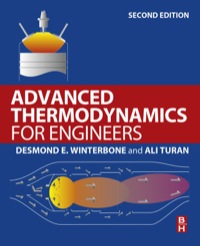The rate of change of mole concentration of constituent (A) in a chemical reaction is expressed as
Question:
The rate of change of mole concentration of constituent \(A\) in a chemical reaction is expressed as
\[\frac{\mathrm{d}[\mathrm{A}]}{\mathrm{d} t}=-k[\mathrm{~A}]^{\mathrm{n}}\]
While mole concentration is the dominant property in the reaction it is much more usual for engineers to deal in mole fractions of the constituents. Show that the rate of change of mole fraction of constituent \(\mathrm{A}\) is given by
\[\frac{\mathrm{d} x_{\mathrm{A}}}{\mathrm{d} t} \propto-k x_{\mathrm{A}}^{\mathrm{n}} ho^{\mathrm{n}-1}\]
where \(ho=\) density. Also show how the rate of change of mole fraction is affected by pressure. \(\left[\mathrm{d} x_{\mathrm{A}} / \mathrm{d} t \propto p^{\mathrm{n}-1}\right]\)
Step by Step Answer:

Advanced Thermodynamics For Engineers
ISBN: 9780080999838
2nd Edition
Authors: D. E. Winterbone, Ali Turan





